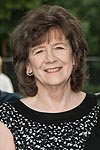Sue Grommes retires after 36 years at the laboratory
 |
|
Sue Grommes
|
Sue Grommes came to Fermilab in 1979, soon after Leon Lederman was named laboratory director. After 36 years and five directors, she retires. Her last day is Friday.
Grommes' first position at Fermilab was as a word processing specialist. One of her first assignments was to help prepare a proposal to build what was then called the Space Telescope (a project that eventually went to NASA: the Hubble Space Telescope). There was no word processing at Fermilab at the time, so Grommes was sent off site to learn to operate a free-standing word processing unit. She soon became a full-time employee and learned each word processing system as it was introduced at the laboratory.
"I can't believe, when I look back now at the papers, design reports and books, that I typed those very complicated scientific equations," she said. "I kept wanting to say, 'Buy a vowel!'"
Advances in word processing programs allowed Grommes to move on to other projects for the Directorate, where she worked as an administrative assistant. She served as gatekeeper for Directorate electronic requisitions, oversaw conference room scheduling and assisted with a large variety of special projects. For 10 years, she also assisted at the annual Physics Advisory Council meetings in Aspen, Colorado.
Grommes also took advantage of life outside Wilson Hall. She played in the summer and winter volleyball leagues, served on the History Committee and participated in the annual Farmers Picnics.
She feels proud to have played an important part in advancing Fermilab's mission.
"It was so rewarding to type papers for projects that would eventually become realities: Illinois Math and Science Academy, CDF, Energy Doubler, Friends of Fermilab, and whole books, such as typing into Cyber the entire 400 pages of the proceedings of the first Fermilab History Symposium, a volume that ended up becoming the first computer-printed book undertaken by Cambridge University Press," she said.
During retirement, she will continue to take care of her mother, volunteer for a Christian organization and pursue her interest in World War II by helping with an honor flight. She also plans to dust off her roller blades and bicycle.
"I have enjoyed so much working for all the different directors and my co-workers in the office, as well as working relationships with others all over the site," Grommes said.
|